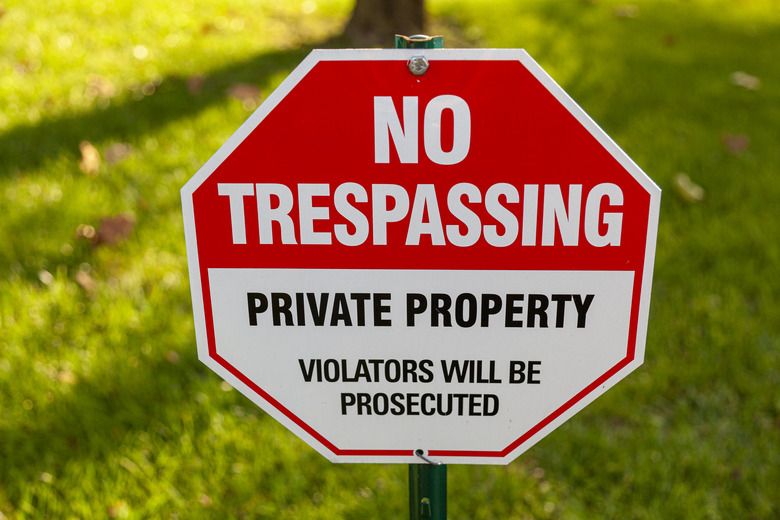How To Properly Display No Trespassing Signs
When displaying "No Trespassing" signs, be sure to make them visible, readable and place them at boundaries where people might enter your property. Be aware of local laws related to trespassing, as well.
Since many courts consider how effectively a property was labeled "private" when presented with a trespassing case, it's important for property owners to know how to properly display "No Trespassing" signs. Preventive measures are an effective way to protect your residential or business property from trespassers. Follow these steps to safeguard your holdings.
Be aware, however, that you may be held responsible if someone harms themselves on your property, even if it's a residential plot. In many states, it is illegal to detain trespassers by placing them under citizen's arrest. Detaining trespassers by force could incur a lawsuit.
Post Clearly Marked Signs
1. Use More Than One Sign
Arm yourself with numerous signs alerting potential trespassers that your property is private and that trespassers will be prosecuted.
2. Place Signs at Your Property Lines
Know your property lines. For example, if you own a shopping center, you shouldn't wait until potential loiterers and trespassers enter the building to warn them about trespassing. Instead, place signage around the edges of the parking lots. If you don't know how your property line is drawn, you may be able to find the land survey pins.
3. Post at Boundaries, Paths or Shortcuts
Post the signs where people easily can see them. If you are posting around a residential property, post at any place on the boundary line that pedestrians or vehicles use as a path or shortcut. Consider putting up a fence, as well.
Make the Signs Visible
1. Ensure the Signs Are Clean and Readable
Keep the signs bright and clean. Even if you properly display a "No Trespassing" sign, it's worthless if the letters have faded or the sign has fallen to the ground. If you are running a business, ask security to check signs regularly during rounds.
2. Add Signs at Places Where People Enter
Continue to place signs at new areas of ingress. If you see anyone cutting across your property, place a sign in that area, and consider building a more effective barrier.
3. Know Your Local Trespassing Laws
Study your local laws. In many states, hunters cannot pursue wounded game onto your property without asking permission. If your property abuts hunting grounds, prominently post signs and consider fencing. Wire fences can provide cheap, effective borders around your property.
4. Make Exceptions If Some People Are Allowed
If you wish to allow some people onto your property, add the words "Ask Permission" in bold or brightly colored letters at the bottom of your signs, or create a custom sign. You can allow certain groups onto your property while excluding others. For instance, you have the right to post signs that welcome hikers while excluding hunters. Business directories can guide you to a sign maker who can offer long-lasting signs that will allow you to properly display your warnings.
Take Further Action
1. Call the Police If Necessary
Call the police if trespassers refuse to leave once they have been notified of their offense.
2. Escalate If the Problem Becomes Chronic
Seek support and guidance if trespassing turns into a serious, chronic problem.
